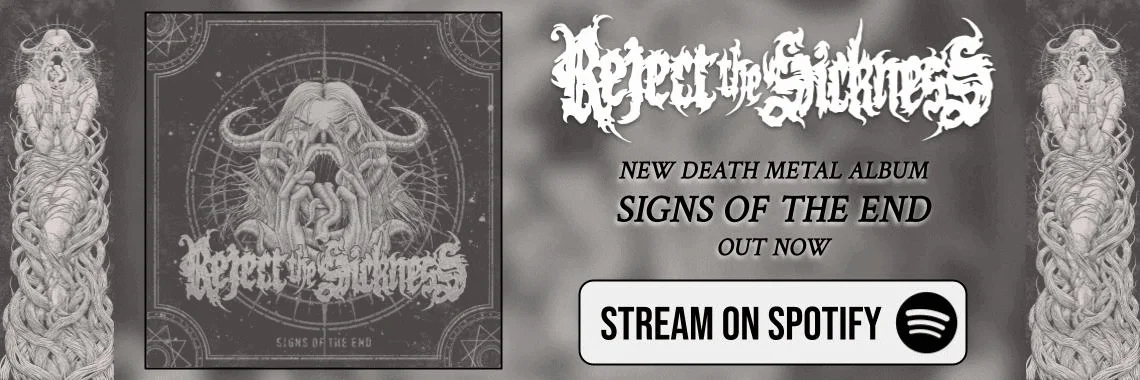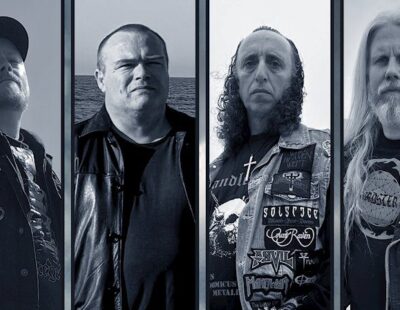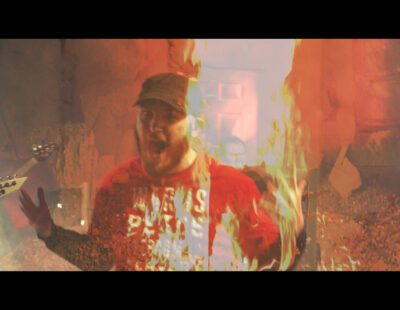It took a lot of guitar amplification to put together Pombagira’s fourth album, Iconoclast Dream. We’re talking some 19, 20 vintage amps and cabs in the arsenal; that’s overkill for most bands, even those more mob-handed in personnel would struggle to justify having such an inventory. But with extreme doom, where tempos are slow and every texture crucial, a boutique, deluxe tone is the MacGuffin that has all exponents of the genre in a perpetual state of self-refinement; cripplingly expensive or not; those amps are crucial to Pombagira’s sound. Iconoclast Dream is big, cinematic, nightmarish and intimidating; rendering a whole album as a single-track is a declaration of intent and an exhortation to invest in the album as a whole rather than a something divisible into tracks/chapters/whatever. But moreover, it’s the voodoo that informs Pombagira’s sound and ethos that’s all the more crucial to understanding and appreciating the band.
Carolyn (drums) and Pete (vocals/strings) Hamilton-Giles named the band after a consort of Exu’s, an Afro-Brazilian spirit from the religion Quimbanda; while Haitian voodoo has been long-standing obsession of Pete’s. “I’ve always been interested in the Occult,” he says. “I suppose in the late ‘80s I was becoming more interesting in that, but more mainstream, like the O.T.O., the Typhonian O.T.O., and it just didn’t really sit well, the sort of hierarchical system that you had to work in. Voodoo was something I was aware of from films like Live and let Die, but from there the fascination grew: it doesn’t have a doctrine; every temple is autonomous and I kind of like that. There isn’t an orthodoxy in any way shape or form. Obviously, it incorporates Catholicism into its religious and spiritual beliefs. I did a degree in anthropology which led me to spend two to three weeks in Haiti, in ’96, where I participated in voodoo ceremonies, recorded lots of music that people played to me. That really cemented my relationship to the religion. Since then, pretty much everything I’ve done has had a tip of the cap to voodoo.”
It’s maybe the ritualistic otherworldliness of Third World religion that propels Iconoclast Dream with a sort of out-of-consciousness sense of purpose. The whole voodoo gives the Electric Wizard-esque doomola with a dark, psych-vibe that’s a real mood-changer for sure; but Iconoclast Dream is accessible in its own right by virtue for having actual hooks, and for-all-intents songs within one epic track. It was written as a stream of consciousness but isn’t an abstract meditation/drone album, and should be a go-to album for all those of you chasing big riffs and the warm, fuzzy lysergic vibe of ’70s horror.
How did Iconoclast Dream come together?
PH-G: We were talking to a friend, Jamie Elton, who does sound engineering down at the Purple Turtle and occasionally worked at Earthworks Studios in Barnet. He came over in Christmas and he knew about my fucking woes about trying to record and capture the Pombagira sound. He said, ‘Why don’t you come down and try it out? It’s not going to cost you. I’ll get a really good rate; I’m not going to charge for my time so it’ll be £120 a day.’ We were there for two days and recorded the album for 240 quid Because all the mixing was free.
CH-G: I could only come to the mixing sessions during one day because the smell of sewage was making me crazy.
PH-G: it was underground; there was a back-up in the sewer; the whole place just smelled of shit. She couldn’t handle it the whole time. It leaves us in a dilemma because it means we can’t go anywhere else, though; although, of course, we’ll pay Jamie for any subsequent recording, it’s still ridiculously cheap compared to any other recording studio in London. As a two-piece, we’re not writing the songs and working out where the lead harmonies might to be: it’s all done on the hoof. I’ll be there and just hear something and want to do this or that and she’ll be like, ‘No, no, no! Don’t do it.’ Some of the time it’ll work; most of the time it does work
You’ve delivered it as one track but it sounds multi-chaptered.
PH-G:To be honest I don’t see it as being multi-chaptered. I can see why people might see it like that but for me it’s just a stream of consciousness.
CH-G: It doesn’t feel like that when you’re playing the drums. Like there’s all these little rest points, so I can have a little bit of a drink, a bit of a break. But other than that it’s just a case of playing the song straight, and it’s very hard.”
PH-G: “We had the song. We had Iconoclast Dream but we absolutely fucking ditched it. There were lots of aspects of the song that we didn’t fucking like—primarily that it sounded far too fucking happy, it’s overall appearance. When Jamie approached us and asked us if we wanted to come in and try some things out, even he, and I, didn’t know that we’d be coming in with a 42-fucking-minute song. It was a selection of riffs that we’d stolen from the original version of Iconoclast Dream. And then it was a question of days, sitting in the rehearsal room at home, just me, going, ‘Well, if I do this I can kind of imagine how I want to do the drums’ and I wanted the drums to be the absolute opposite of what I was doing, so say for example in the 12 minute section, when the guitar starts to drone out in a very drawn-out note, the drums aren’t sticking about in a typical doom one-two-three-four thing. I wanted her to do a full-on Jimi Hendrix rock out drum solo as an absolute juxtaposition to the guitar. And if she does this and it stops after a certain number of times then that will give her a break, I can then have an opportunity, not to take the starlight, but to do something absolutely different to anything else we’ve done, totally sitting back on its haunches, not being loud, not being brash, being much more reflective; then when we put the fuzz pedal back on with the reverb and the delay it sounds fucking massive. Even though it’s not any different how it was before that really quiet section with me playing on my own. When it comes back in it sounds so much different—it was like reaching the point where you could understand how to manipulate textures to articulate the things we wanted to try convey.
How do you write all this down?
CH-G: There was a lot of arguing. It was not a pleasant one to do. There are some songs we argue over real bad—being married—and Iconoclast Dream was one of them, because I am very much like ‘That’s shit. That’s not going to work.’ And he doesn’t take criticism very well and I don’t take criticism very well. In the end the compromise comes and it’s better. I had to have lots of crib sheets for this.
PH-G: I presented it to Carloyn as, ‘See how you’ve been playing? That isn’t going to happen.’ So suddenly I’m really, really pushing her and I’m not a fucking drummer so I don’t understand the mechanics—you know what I mean? The tripped out section was just a jam. We did that two days before.”
CH-G:“We did that the day before. We did that in the recording studio. We figured that out the day before and did one practice in the recording studio. I felt it needed something for me to pull it together. You can’t expect someone to play and not know what the other is going to do; I needed something to come back to. I needed to know what you were doing. It was way more freeform before that, just random shoegazy, didn’t follow any rhythm…
PH-G: I kinda liked that…
Being a duo, there’s no casting vote to help with the decision making.
CH-G: It’s my fucking vote! That’s the one; my vote counts for two and yours is for one. That’s how it works.
Does your tone obsession stretch to all-analog recording?
PH-G: “Analog hasn’t really worked for us as far as recording goes. The songs are so long; the money’s so tight: we can’t afford to keep doing retake after retake. For the previous album, Baron Citadel, we tried recording a Chuckalumba down in Dorset, where obviously Electric Wizard recorded Dopethrone—fucking absolute disaster. We did actually try and do Iconoclast Dream then but it was a very different song then, it was a 22-minute song. Finally we recorded Baron Citadel at Leaders Farm up in Norfolk, which is owned by the guy who worked with Oasis—again, not terribly happy with the recordin
How did you choose the samples?
PH-G: To be honest I can’t even remember how I came across those samples, but when I heard that poem from Adrian Mitchell the hairs on the back of my neck stood up. It had that sense of anger but at the same time had a kind of beauty to it that no punk band could ever articulate in such a fashion. Of course, this comes as a juxtaposition to the lyrical content of the song but at the same time but underlying it there’s still that same message of looking back, honouring the dead, the mortal coil of life, and Adrian Mitchell was doing it in a different kind of way but articulating the same emotions that we wanted to articulate. I’ve had people saying that this would have better suited a Flyblown release than a Pombagira release but ultimately it has a ‘60s naivety to and that’s an era that I’m interested in.





